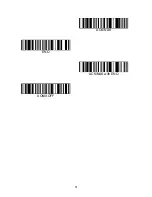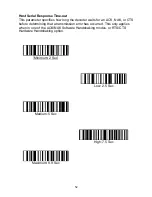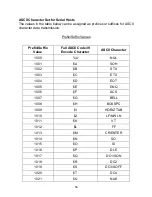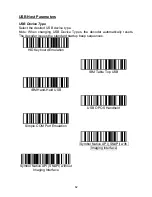
48
Hardware Handshaking
The data interface consists of a serial port designed to operate either with or
without the hardware handshaking lines,
Request to Send
(RTS), and
Clear to
Send
(CTS).
If Standard RTS/CTS handshaking is not selected, scan data is transmitted as
it becomes available. If Standard RTS/CTS handshaking is selected, scan data
is transmitted according to the following sequence:
y
The decoder reads the CTS line for activity. If CTS is asserted, the
decoder waits up to Host Serial Response Time-out for the host to
de-assert the CTS line. If, after Host Serial Response Time-out
(default), the CTS line is still asserted, the decoder sounds a
transmit error, and any scanned data is lost.
y
When the CTS line is de-asserted, the decoder asserts the RTS
line and waits up to Host Serial Response Time-out for the host to
assert CTS. When the host asserts CTS, data is transmitted. If,
after Host Serial Response Time-out (default), the CTS line is not
asserted, the decoder sounds a transmit error, and discards the
data.
y
When data transmission is complete, the decoder de-asserts RTS
10 msec after sending the last character.
y
The host should respond by negating CTS. The decoder checks for
a de-asserted CTS upon the next transmission of data.
During the transmission of data, the CTS line should be asserted. If CTS is
disserted for more than 50 ms between characters, the transmission is aborted,
the decoder sounds a transmission error, and the data is discarded. If the
above communication sequence fails, the decoder issues an error indication. In
this case, the data is lost and must be rescanned. If Hardware Handshaking
and Software Handshaking are both enabled, Hardware Handshaking takes
precedence.
Note: The DTR signal is jumpered to the active state.
y
None: Scan the bar code below if no Hardware Handshaking is
desired.
y
Standard RTS/CTS: Scan the bar code below to select Standard
RTS/CTS Hardware Handshaking.
y
RTS/CTS Option 1: When RTS/CTS Option 1 is selected, the
decoder asserts RTS before transmitting and ignores the state of
CTS. The decoder de-asserts RTS when the transmission is
complete.
y
RTS/CTS Option 2: When Option 2 is selected, RTS is always high
or low (user-programmed logic level). However, the decoder waits
for CTS to be asserted before transmitting data. If CTS is not
asserted within Host Serial Response Time-out (default), the
Summary of Contents for Z-3052
Page 1: ......
Page 51: ...44 Baud Rate 9600 Baud Rate 19 200 Baud Rate 38 400 Baud Rate 57 600 Baud Rate 115 200...
Page 58: ...51 ACK NAK ENQ ACK NAK with ENQ XON XOFF...
Page 124: ...117 D 2 of 5 Lengths Within Range D 2 of 5 Any Length...
Page 147: ...140 Redundancy Level 1 Redundancy Level 2 Redundancy Level 3 Redundancy Level 4...
Page 179: ...172 8 9 Cancel To correct an error or change a selection scan the bar code below Cancel...






























